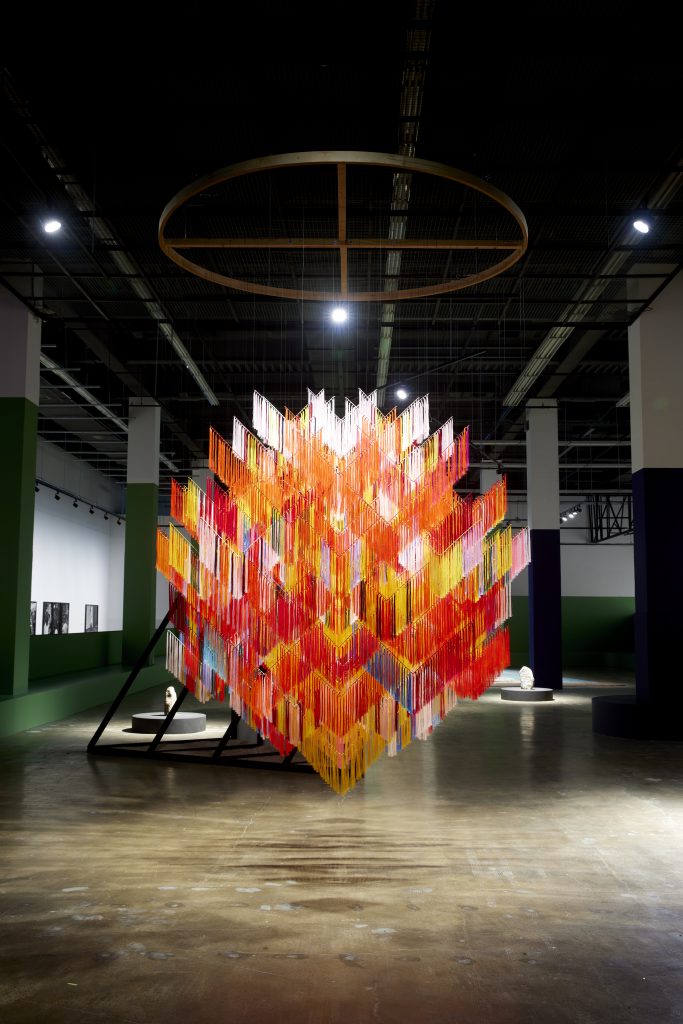
Outi Pieski, Beavvit II/ Rising Together II, 2020 Installation: metal, thread 250 × 250 × 250 cm, co-commissioned by the 13th Gwangju Biennale and Bonniers Konsthall, Stockholm Supported by Frame Contemporary Art Fund Finland
Outi Pieski, Beavvit II/ Rising Together II, 2020 Installation: metal, thread 250 × 250 × 250 cm, co-commissioned by the 13th Gwangju Biennale and Bonniers Konsthall, Stockholm Supported by Frame Contemporary Art Fund Finland

In the curators’ first meeting with Sámi artist and activist Outi Pieski in 2018, she invoked the landscape encountered during her frequent fifteen-hour commute between her base in Ohcejohka (Utsjoki) and Helsinki as intrinsically enlivening her practice. Pieski’s paintings and installations converse with the Arctic region and give form to the interdependence of nature and culture that has shaped the life practices of the indigenous Sámi community. Combining craft traditions as somatic and familial vocabularies called duodji, several of Pieski’s installations include wood, silver, and textile handicrafts threatened by Scandinavian colonialism, assimilation policy, religious conversion, and transformations in material culture. Pieski opens intergenerational dialogues around knowledge of the handmade as a feminist articulation and toward a transfer of consciousness that avows the Sámi principle of “agreeable life” (soabalaš eallin) and counters forgetting.
Since 2017, she has collaborated with archaeologist Eeva-Kristiina Harlin on the project Máttaráhku ládjogahpir (A Foremother’s Hat of Pride). Women in the Northern part of Sápmi wore the ládjogahpir hat during the nineteenth century, but the spread of Laestadianism, a pietistic Christian movement, erased this practice. Through this project, on view at Gallery 2, and in their essay within the Biennale’s online journal and reader, Pieski and Harlin rekindle ancestral links through the ládjogahpir as cultural heritage and mobilize the terms of “rematriation” as a matrilineal mode of belonging, collective remembering, and entitlement. For Pieski, violence against women is synonymous with the plundering of the Earth and the ruthless disrespect of natural resources as they are guarded by the áhkkás, Sámi female spirits depicted in her ongoing series of goddess paintings.
Beavvit II/ Rising Together II. (2020), Pieski’s major installation greeting visitors in the entrance area of the Biennale Hall, alludes to community dress and social modes of gathering. Created collaboratively, the artist imagines this “three-dimensional painting” as a textile architecture of handwoven knots that echoes calls for self-determination and kinship, and, inevitably, destabilizes the hierarchy between contemporary art and artisanal creative processes.
Outi Pieski, Beavvit II/ Rising Together II, 2020 Installation: metal, thread 250 × 250 × 250 cm, co-commissioned by the 13th Gwangju Biennale and Bonniers Konsthall, Stockholm Supported by Frame Contemporary Art Fund Finland